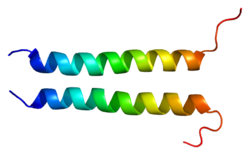T-cell surface glycoprotein CD3 zeta chain also known as T-cell receptor T3 zeta chain or CD247 (Cluster of Differentiation 247) is a protein that in humans is encoded by the CD247 gene.
Some older literature mention a similar protein called "CD3 eta" in mice. It is now understood to be an isoform differing in the last exon.
Genomics
The gene is located on the long arm of chromosome 1 at location 1q22-q25 on the Crick (negative) strand. The encoded protein is 164 amino acids long with a predicted weight of 18.696 kiloDaltons.
Function
T-cell receptor zeta (ζ), together with T-cell receptor alpha/beta and gamma/delta heterodimers and CD3-gamma, -delta, and -epsilon, forms the T-cell receptor-CD3 complex. The zeta chain plays an important role in coupling antigen recognition to several intracellular signal-transduction pathways. Low expression of the antigen results in impaired immune response. Two alternatively spliced transcript variants encoding distinct isoforms have been found for this gene.
Interactions
CD247 has been shown to interact with Janus kinase 3 and Protein unc-119 homolog.
See also
References
- ^ GRCh38: Ensembl release 89: ENSG00000198821 – Ensembl, May 2017
- ^ GRCm38: Ensembl release 89: ENSMUSG00000005763 – Ensembl, May 2017
- "Human PubMed Reference:". National Center for Biotechnology Information, U.S. National Library of Medicine.
- "Mouse PubMed Reference:". National Center for Biotechnology Information, U.S. National Library of Medicine.
- Weissman AM, Hou D, Orloff DG, Modi WS, Seuanez H, O'Brien SJ, Klausner RD (December 1988). "Molecular cloning and chromosomal localization of the human T-cell receptor zeta chain: distinction from the molecular CD3 complex". Proc. Natl. Acad. Sci. U.S.A. 85 (24): 9709–13. Bibcode:1988PNAS...85.9709W. doi:10.1073/pnas.85.24.9709. PMC 282845. PMID 2974162.
- Clayton LK, D'Adamio L, Howard FD, Sieh M, Hussey RE, Koyasu S, Reinherz EL (June 1991). "CD3 eta and CD3 zeta are alternatively spliced products of a common genetic locus and are transcriptionally and/or post-transcriptionally regulated during T-cell development". Proceedings of the National Academy of Sciences of the United States of America. 88 (12): 5202–6. doi:10.1073/pnas.88.12.5202. PMC 51840. PMID 1828894.
- "Entrez Gene: CD247 CD247 molecule".
- Tomita K, Saijo K, Yamasaki S, Iida T, Nakatsu F, Arase H, Ohno H, Shirasawa T, Kuriyama T, O'Shea JJ, Saito T (Jul 2001). "Cytokine-independent Jak3 activation upon T cell receptor (TCR) stimulation through direct association of Jak3 and the TCR complex". J. Biol. Chem. 276 (27): 25378–85. doi:10.1074/jbc.M011363200. PMID 11349123.
- Gorska MM, Stafford SJ, Cen O, Sur S, Alam R (Feb 2004). "Unc119, a novel activator of Lck/Fyn, is essential for T cell activation". J. Exp. Med. 199 (3): 369–79. doi:10.1084/jem.20030589. PMC 2211793. PMID 14757743.
Further reading
- Geyer M, Fackler OT, Peterlin BM (2001). "Structure--function relationships in HIV-1 Nef". EMBO Rep. 2 (7): 580–5. doi:10.1093/embo-reports/kve141. PMC 1083955. PMID 11463741.
- Greenway AL, Holloway G, McPhee DA, Ellis P, Cornall A, Lidman M (2004). "HIV-1 Nef control of cell signalling molecules: multiple strategies to promote virus replication". J. Biosci. 28 (3): 323–35. doi:10.1007/BF02970151. PMID 12734410. S2CID 33749514.
- Stove V, Verhasselt B (2006). "Modelling thymic HIV-1 Nef effects". Curr. HIV Res. 4 (1): 57–64. doi:10.2174/157016206775197583. PMID 16454711.
External links
- CD247+protein,+human at the U.S. National Library of Medicine Medical Subject Headings (MeSH)
- Human CD247 genome location and CD247 gene details page in the UCSC Genome Browser.
- Overview of all the structural information available in the PDB for UniProt: P20963 (Human T-cell surface glycoprotein CD3 zeta chain (CD247)) at the PDBe-KB.
| PDB gallery | |
|---|---|
| Proteins: clusters of differentiation (see also list of human clusters of differentiation) | |
|---|---|
| 1–50 | |
| 51–100 | |
| 101–150 | |
| 151–200 | |
| 201–250 | |
| 251–300 | |
| 301–350 | |
This membrane protein–related article is a stub. You can help Misplaced Pages by expanding it. |






